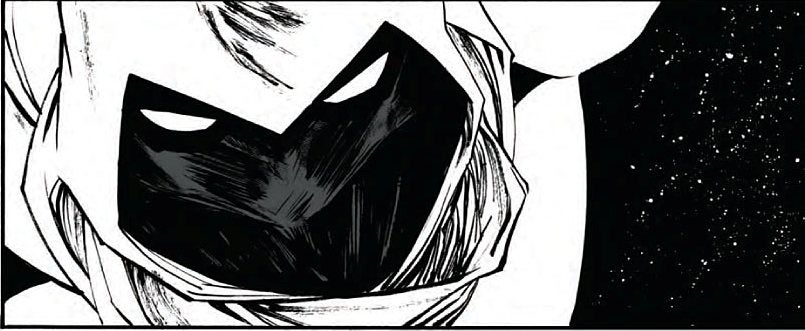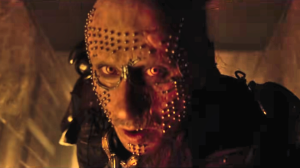
The true winners to emerge from Marvel NOW! (and All-New Marvel NOW!) have been the street-level characters and those readers who indulge in their tales. This was, perhaps, inevitable. Properties like “Moon Knight,” “Daredevil,” and “Ghost Rider,” as a default narrative position, have the least to lose and the most to gain from reboots or relaunches. They’re not so high-profile that their features and personalities are immutable and they’re also not so obscure that they don’t have an interested readership. In other words, after Marvel NOW!, no one could have reasonably expected too big a shakeup in the X-Office; even the most optimistic Marvel readers didn’t predict a groundbreaking new direction in Jonathan Hickman’s twin Avengers titles (even if that’s what they were promised). The street characters were the ones that brought the heat, and Moon Knight has been burning the brightest.
But as with all things, the flame that burns twice as bright burns half as long. Shortly after Warren Ellis and Declan Shalvey had begun their run, it was revealed that the duo would produce no more than 6 issues. Moon Knight #6 hits shelves this August and though it is the terminal point for the run, it will also be the culmination of an extraordinary Marvel Comic. Here’s why:
In a way, first issues are worse than television pilots (which are terrible). In first issues writers often incessantly catalogue the previous exploits of the protagonist to catch the reader up to date. This first issue tradition is clunky, wasteful, and detrimental to the initial momentum that a new launch requires. Ellis and Shalvey dispense with it almost entirely, instead dropping the reader right into Moon Knight’s perpetual nighttime version of New York, choosing to fill readers in subtly and efficiently as they move the story along. You do not have to read up on the character to dig in. In Moon Knight #1 we’re treated to a swift introduction of the character, members of his supporting cast, and then thrown into an excellently choreographed action sequence that closes out the book. It’s utterly effective and almost too simple. But before we even catch a glimpse of Panel 1, we must start with the introduction page.
Each Moon Knight issue begins with this simple statement:
“Mercenary Marc Spector died in Egypt, under a statue of the ancient deity Khonshu. He returned to life in the shade of the moon god, and wore his aspect to fight crime for his own redemption. He went completely insane, and disappeared.
This is what happened next.”
The exploration of sanity is integral to Moon Knight’s appeal. It’s very easy to say that Moon Knight is a ripoff of Batman (he very well might be) but it is the difference, not the similarity, between the Fist of Khonshu and the Caped Crusader where things get interesting. Depending on your interpretation, Bruce Wayne is the real person behind the mask of Batman (a good argument can be made for the reverse). Not only that, but Wayne can be said to wear another mask, that of the public persona of the playboy billionaire. That’s a great concept and one that’s given creators mileage with the character for decades.
But no matter which side of the argument you fall on, there’s only one actual person: Bruce Wayne or Batman. The other two “people” are the masks he camouflages his true nature with.
Here’s the thing about Moon Knight: he’s literally three people.
Whether it’s Marc Spector/Jake Lockley/Steven Grant (“Moon Knight” Volume 1) or Wolverine/Captain America/Spider-Man (“Moon Knight” Volume 5) Moon Knight has always been a fusion of three consubstantial entities operating from within the same body. Ellis and Shalvey acknowledge these past trinities but forge ahead in this new volume with a streamlined perspective. This time, Moon Knight, as the “the Watcher of Overnight Travelers,” has three distinct uniforms that highlight a different aspect of his crime fighting function (and of course, his psyche). Two of them are hilarious, one of them is standard.
Videos by ComicBook.com
All of the Moon Knight personas are interesting, but it is Mr. Knight (the one with the three piece suit) that Ellis and Shalvey choose to lavish with their greatest material. And in what might be the most inspired coloring decision of Jordie Bellaire’s early career, Mr. Knight is rendered completely without color. In the way Batman has always slunk in and sprung from the shadows, Mr. Knight bursts from the very gutters of the page, standing—not hiding—in plain sight. Knight tells people more than once that the reason he wears white is so that crooks will see him coming.
Mr. Knight is the lens through which Ellis most often chooses to examine the (in)sanity of Marc Spector. After all, what kind of night faring vigilante would want his enemies to see him coming at them in a ludicrously bespoke three piece suit? But the strange, and perhaps telling, aspect of this investigation of the mind is that Mr. Knight is presented as undeniably sane for the entirety of the series. Sure, a blogger who recounts Moon Knight’s story at the beginning of issue #1 refers to him as a crazy person, and even Moon Knight himself agrees with that consensus, but at no point is he shown to be anything other than a logical, pragmatic, and capable (if somewhat brutal) crime fighter. This dichotomy between the perception of Moon Knight’s sanity and his actual mental health is made clear in an issue #1 sequence wherein Mr. Knight issues a command to the driver of his all-white stretch limo. We soon find out that no one is driving the vehicle. Knight is talking to no one. And if the sequence ended there, we would have all the proof we needed that he was indeed a lunatic. But it doesn’t end there. Mr. Knight’s limo is piloted by a voice-activated A.I. Why shouldn’t he talk to the invisible man in the front seat? The invisible man is a computer.
If I were someone who hasn’t read “Moon Knight” and I found myself at this point in this article, I might assume that Ellis and Shalvey’s take on Marc Spector and his alter ego is a bit too cerebral, a bit too intellectual for a Marvel Comic. But if I thought that, I would be wrong.
Moon Knight is one the most beautifully violent action comics to come out of Marvel in years.
This is no more apparent than in Moon Knight #5 where, in the grand tradition of “Die Hard” and “The Raid,” Mr. Knight must make his way to the top of a ratty tenement building to rescue a young girl, beating criminals to death as he moves from floor to floor. This next statement may be controversial, but I have yet to hear a concise argument against it: Moon Knight #5 is the best single issue of the year.
Issue #5 solidifies Warren Ellis as one of the masters of action scripting. But it is through the expert line of Declan Shalvey’s pen that each bone-crunching encounter in Ellis’ script is imbued with excruciating detail and grace. This is refreshing given the state of action storytelling in our modern times. In most comics we’re lucky to see an actual fight sequence occur across a single page, much less a play by play backbreaker takedown. In Moon Knight #5 we are given these things in abundance. Looking back, it is possible to see issues #1-4 as a warmup to this penultimate episode, an insane battle royale where all that we have learned about Moon Knight, his skills and his mission and his god Khonshu, are synthesized into the ultimate comic book artifact. This is the unicorn. This is what comic books are capable of.
To quote True Detective’s Rustin Cohle, the other insane-yet-sane crime fighter of 2014, “time is flat circle,” and as such, the tale of Moon Knight must end where it begins. And it begins with the progenitor, that other caped vigilante whom we all know so well. In Moon Knight #1 Marc Spector enters his cobwebbed mansion (a Wayne Manor facsimile) and sits in the chair that Bruce Wayne once sat in, the time that he declared to his long gone father that he would become a Bat. But here in Moon Knight’s world, his father is an extradimensional god who demands that vengeance be enacted in his name and haunts Moon Knight’s every move. Batman is the story of a man who had to become sane because his father was killed in front of his eyes. But Moon Knight is the story of a man who’s become insane because his father is still very much alive.
Or maybe not. Maybe I’m wrong. Maybe it’s just the story of a man in a bird suit who beats people to death. Either way, can you really afford not to read it?
Moon Knight #6 is in stores and available digitally, today.








